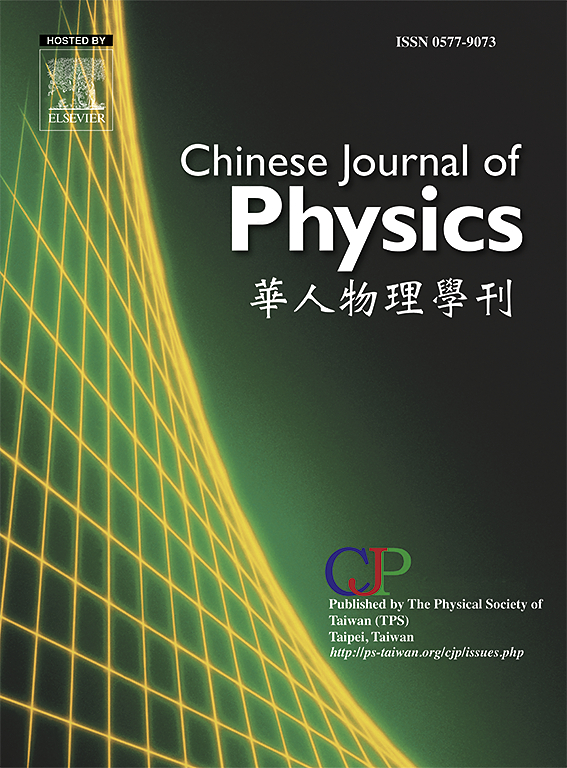Thermal analysis and entropy generation on time-dependent two-phase immiscible non-Newtonian nanofluids through porous tube under electromagnetic effects with slip velocity
IF 4.6
2区 物理与天体物理
Q1 PHYSICS, MULTIDISCIPLINARY
引用次数: 0
Abstract
The present research scrutinized the numerical simulations on the thermal effects of multiphase flow of immiscible Sutterby-Jeffrey nanofluids in a circular cylinder along with slip velocity through the porous region. The influence of Palladium () nanoparticles with distinct shapes was studied, proceeding with hexahedron () shape. The conduit is maintained to be isothermal and the governing equations are constructed for the continuity, momentum, energy and entropy equations along with continuity in the interfacial regions. The different combinations of base fluids Ethylene Glycol and mineral oil are explained and it is certainly proven that Ethylene Glycol performs better than Mineral oil. The dimensionless equations governing each layer were numerically integrated using the finite difference method with the Crank–Nicolson approach. A mesh independence and validation results are conducted. Furthermore, a parametric study is performed under three conditional cases involving the Sutterby parameter, Grashof number, electromagnetic field, and Prandtl number. The comparison was made between , and nanoparticles for the velocity profile and found that the effectiveness of Pd nanofluids was much more efficient than the Au and nanofluids. A binate circumstance was observed in the Bejan number under conditional cases. Meanwhile, the Sutterby parameter and Jeffrey parameter enhanced the entropy generation. In addition, the entropy in region I was less compared to Region II whereas the opposite behaviour was perceived in the velocity profiles.

随滑移速度变化的电磁效应下多孔管内两相非混相非牛顿纳米流体的热分析与熵生成
本文对非混相萨特比-杰弗里纳米流体在圆柱内多相流动的热效应进行了数值模拟。以六面体(n2=3.72)形状为研究对象,研究了不同形状的钯纳米颗粒对其性能的影响。保持管道的等温状态,并建立了界面连续性、动量、能量和熵方程的控制方程。解释了基础流体乙二醇和矿物油的不同组合,并肯定证明乙二醇的性能优于矿物油。利用有限差分法和Crank-Nicolson方法对控制每一层的无量纲方程进行数值积分。进行了网格独立性分析和验证。在此基础上,对萨特比参数、格拉索夫数、电磁场和普朗特数三种情况进行了参数化研究。对比了钯、TiO2和Au纳米流体的速度分布,发现钯纳米流体的效率远高于Au和TiO2纳米流体。在有条件的情况下,在Bejan号码中观察到一种双重情况。同时,Sutterby参数和Jeffrey参数增强了熵的产生。此外,与区域II相比,区域I的熵更少,而在速度剖面中可以感知到相反的行为。
本文章由计算机程序翻译,如有差异,请以英文原文为准。
求助全文
约1分钟内获得全文
求助全文
来源期刊

Chinese Journal of Physics
物理-物理:综合
CiteScore
8.50
自引率
10.00%
发文量
361
审稿时长
44 days
期刊介绍:
The Chinese Journal of Physics publishes important advances in various branches in physics, including statistical and biophysical physics, condensed matter physics, atomic/molecular physics, optics, particle physics and nuclear physics.
The editors welcome manuscripts on:
-General Physics: Statistical and Quantum Mechanics, etc.-
Gravitation and Astrophysics-
Elementary Particles and Fields-
Nuclear Physics-
Atomic, Molecular, and Optical Physics-
Quantum Information and Quantum Computation-
Fluid Dynamics, Nonlinear Dynamics, Chaos, and Complex Networks-
Plasma and Beam Physics-
Condensed Matter: Structure, etc.-
Condensed Matter: Electronic Properties, etc.-
Polymer, Soft Matter, Biological, and Interdisciplinary Physics.
CJP publishes regular research papers, feature articles and review papers.
 求助内容:
求助内容: 应助结果提醒方式:
应助结果提醒方式:


